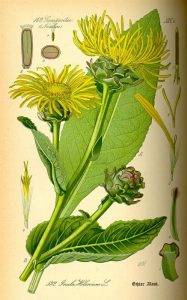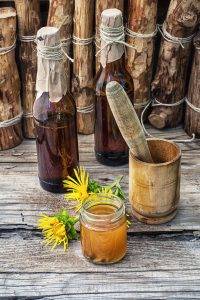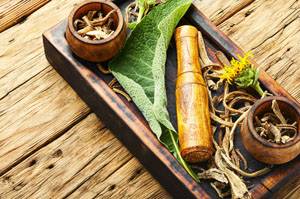
Fennel Root – Inula Helenium
Description of fennel root:
Inula Helenium L. (Old or other familiar names: peremizis, whirl-root, magnificent fennel, magnificent whirl-root) Nests – Compositae Armenian root is a perennial plant, known and used since ancient times. It does not flower in the first year, but only produces a few leaves with a few stems, and only flowers from the second year onwards. The root grows to 20 cm long and 6 cm thick and branches out profusely. The stems are erect and strong, growing up to 1.5 or even 2 m tall, with rough edges and soft hairs on the top and felted edges. The leaves are very large; the bracts are 30-40 cm, sometimes 1 m long and 8-12 or even 20 cm wide; those on the stem are much smaller. The bracts are short-tongued, the lobes running down the stem, the ones on the stem are sessile, with a cordate base, semi-stalkless. Leaves oblong-ovate, pointed, with irregularly toothed margins. The upper leaf blade is wrinkled and rough, and the back of the leaf is inverted and felty. The sides of the sparsely branched stem are enclosed by a single large saucer-shaped flower head. The flowers are yellow in colour and form respectable flower heads, surrounded on the outside by a green collar. The flowers produce 4 mm long and 1 mm thick brownish brown monocotyledons crowned with yellowish-white hairs. The wind easily picks up and carries away these tufted fruits. Armenian root flowers from July to September (sometimes until the first frost).
Occurrence:
Armenian Root grows in wet meadows, alongside rivers and streams, in vineyards and orchards, in bogs and mountain scrub. In the wild, it is probably found only in the south and east of the country, but in the wild it grows on the banks of rivers, in wet meadows and rocky places throughout the country, even in the county of Arav, and in Transylvania. In Hungary (native) it occurs in the Cserhát, Börzsöny and Nyírség. The Armenian root has long been cultivated as a medicinal plant in gardens and has spread from there to the surrounding area. It is still cultivated in many regions. It is easily grown by sowing seeds. It is native to Asia Minor. It used to be grown at the foot of castles, to be obtained close to the time of great feasts to aid digestion.
Medicinal properties and uses of fennel root:
The underground stem and root of armeric root (or peremizis) are used in medicine under the names radix helenii, radix inulae and radix enulae. The root has a peculiar spicy smell, reminiscent of camphor when fresh. The taste is unpleasant at first, then pungent, bitter and spicy. Its root contains volatile oil, alanthamfort or helenin, inulin and a bitter substance. Armenian root acts mainly on the mucous membranes and is therefore used against lung ailments and mucus. Its decoction is used against coughs, bronchitis, and externally against skin rashes (dirt, scabies, fungal infections – microsporum and thichophyton). The Armenian root and must are used to make the so-called ‘alantbor’, which is used to strengthen the stomach (digestive, biliary and intestinal disorders, flatulence) and, according to some accounts, to make soup. Armenian root has been used for urinary tract infections, menstrual cramps and worm castings, but it is also effective against asthma when mixed with other herbs. For insomnia, drink the warm decoction before bedtime. Stress, anxiety, blood pressure, blood sugar and respiratory stimulant. Armenian root was also used in the 1600’s (1906) to make digestive tablets and sugars. Taken in large quantities it can cause vomiting, diarrhoea, constipation, cramps and even paralysis! It is not recommended for pregnant women! Medical supervision is essential! The easiest way to extract the inulin content is to soak the plant overnight and then boil it slowly (the first time inulin was extracted was in the 19th century). It can also be candied, which some say is the best way to extract it. Nowadays, it is more commonly consumed for detoxification, weight loss and to strengthen the immune system, liver and digestive system. It is also used by the liqueur industry, as a base ingredient in diabetic preparations (due to its inulin content) and can be taken by diabetics. (“It used to be official in our Pharmacopoeia, but is no longer official. The root is used in powdered form, especially in folk medicine.”) Active ingredients: Essential oil, helenin, mucilage, bitter substance (1~3%), inulin (~44%), sesquiterpene.
Cultivation: It prefers moist, permeable, (acidic) soil, sunny/semi-shady places. It is not demanding on soil, can live up to 15 years in one place, if propagated, it needs nutrient supplementation and fertilization. Propagation is by sowing seeds and by division. The seeds are sown in March-April (the seeds start germinating at 8-10 °C, but the right temperature is 18-22 °C) or in the month of February or early June. If propagated by division, the seedlings are planted out in September-October at a distance of 60-90 cm between the rows, because of their size, they require a lot of space and their root system spreads quickly, so take this into account for possible later sprouting. The seed requirement is 300-400 grams per acre. Yield per acre from the third year onwards is 8-10 q (hundredweight) of dry roots. It does not require special care (it needs water), is relatively resistant to diseases and pests (it can be mildewed in summer), and can withstand cold and dry winters.
Extract: Armenian root should be dug in autumn or early spring. Select the roots of larger, perennial specimens (at least 2 years old) for digging, as these can grow to fist-thickness. The dug up roots should be cleaned first of soil, then of leaf debris and the thinnest lateral roots. The thicker roots are cut in half lengthwise, cut into smaller pieces and dried quickly. The roots should not be peeled, as they can be identified by the bark of the arrowroot. It has a brownish-white colour on the outside, and when dried it is hard, cold, almost horn-like, but in damp places it absorbs moisture and becomes tough. To dry it, spread it out thinly either on a tarpaulin in the sun or in a ventilated attic. (Some people cut it into small pieces and string them on twine and dry them over a gentle heat.) When it is dry to brittleness, bag it and transport it, 4 kg of raw root will yield 1 kg of dry root. Protected species! Asset value: 5.000 Ft. Alfalfa species:
- Badger peremizs (inula hirta)
- Grass-leaved peremizzi (inula salicina)
Source: Dr. Ferenc Darvas and Dr Gyula Magyary-Kossa,Domestic herbs, their production, marketing, effects and medicinal uses Béla Páter, The wild medicinal plants




